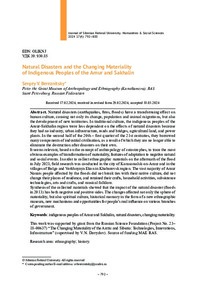Natural Disasters and the Changing Materiality of Indigenous Peoples of the Amur and Sakhalin
Автор:
Bereznitsky, Sergey V
Березницкий, С. В.
Дата:
2024-04Журнал:
Журнал Сибирского федерального университета. 2024 17(4). Journal of Siberian Federal University.Humanities & Social Sciences 2024 17(4)Аннотация:
Natural disasters (earthquakes, fires, floods) have a transforming effect on
human culture, causing not only its change, population and animal migrations, but also
the development of new territories. In traditional culture, the indigenous peoples of the
Amur-Sakhalin region were less dependent on the effects of natural disasters because
they had no industry, urban infrastructure, roads and bridges, agricultural land, and power
plants. In the second half of the 20th – first quarter of the 21st centuries, they borrowed
many components of industrial civilisation, as a result of which they are no longer able to
eliminate the destruction after disasters on their own.
It seems relevant, based on the concept of anthropology of catastrophes, to trace the most
obvious examples of transformation of materiality, features of adaptation to negative natural
and social events. In order to collect ethnographic materials on the aftermath of the flood
in July 2023, field research was conducted in the city of Komsomolsk-on-Amur and in the
villages of Belgo and Verkhnyaya Ekon in Khabarovsk region. The vast majority of Amur
Nanais people affected by the floods did not break ties with their native culture, did not
change their places of residence, and retained their crafts, household activities, subsistence
technologies, arts and crafts, and musical folklore.
Synthesis of the collected materials showed that the impact of the natural disaster (floods
in 2013) has both negative and positive sides. The changes affected not only the sphere of
materiality, but also spiritual culture, historical memory in the form of a new ethnographic
museum, new mechanisms and opportunities for people’s real influence on various branches
of government Природные катастрофы (землетрясения, пожары, наводнения) оказывают
трансформирующее воздействие на культуру людей, вызывая не только её изменение,
миграции населения и животных, но и освоение новых территорий. В традиционной
культуре коренные народы Амуро- Сахалинского региона были менее зависимы
от последствий природных катастроф, так как не имели промышленности, городской
инфраструктуры, дорог и мостов, сельскохозяйственных угодий, энергетических
установок. Во второй половине XX – первой четверти XXI вв. они заимствовали
многие компоненты промышленной цивилизации, вследствие чего самостоятельно
ликвидировать разрушения после катастроф они уже не в состоянии.
Представляется актуальным на основе концепции антропологии катастроф проследить
самые очевидные примеры трансформации материальности, особенности адаптации
к негативным природным и социальным событиям. Для сбора этнографических
материалов о ликвидации последствий наводнения 2013 г. в июле 2023 г. проводились
полевые исследования в г. Комсомольске-на- Амуре, в селах Бельго, Верхняя Эконь
Хабаровского края. Подавляющее большинство амурских нанайцев, пострадавших
от наводнения, не прервали связей с родной культурой, не изменили мест проживания,
сохранили промыслы, домашние занятия, технологии жизнеобеспечения, декоративно-
прикладное искусство, музыкальный фольклор.
Синтез собранных материалов показал, что воздействие природной катастрофы
(наводнения 2013 г.) имеет как негативные, так и позитивные стороны. Изменения
коснулись не только сферы материальности, но и духовной культуры, исторической
памяти в виде нового этнографического музея, новых механизмов и возможностей
реального воздействия людей на различные ветви власти

